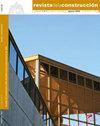碱处理香蕉纤维蜂窝轻量化混凝土力学性能优化
IF 1.4
4区 工程技术
引用次数: 6
摘要
建筑材料发展的最新进展涉及利用植物基天然纤维,如红麻、剑麻、椰子和香蕉,以取代传统纤维,如碳、钢、聚丙烯和芳纶。然而,使用这些纤维的主要问题是碱性水泥基体的耐久性和相容性,因为它具有高吸水性。因此,本研究的重点是利用碱处理香蕉纤维来提高细胞轻量化混凝土(CLC)的力学性能。香蕉纤维分别经过2%、4%、6%、8%和10%的NaOH处理,然后放入密度为1200 kg/m3的CLC中。以普通CLC和未经处理的纤维复合材料(0% NaOH处理)为对照。结果表明,与未处理的纤维复合材料和普通对照CLC相比,在28 d时,6% NaOH纤维处理的抗压、弯曲和劈裂抗拉强度同时提高,峰值分别为40.6%和59.8%,63.8%和117.4%,77.4%和157.8%。6% NaOH处理的BF极大地改善了单纤维和BFRCLC复合材料的力学性能。因此,6%的NaOH处理是香蕉纤维中碱含量最高的处理。本文章由计算机程序翻译,如有差异,请以英文原文为准。
Optimization of mechanical properties of cellular lightweight concrete with alkali treated banana fiber
Recent advancements in construction materials development have involved the utilization of plant-based natural fibers such as kenaf, sisal, coir and banana to replace conventional fibers such as carbon, steel, polypropylene and aramid. However, the main issue with using these fibers is the alkaline cement matrix's durability and compatibility due to high water absorption. Hence, this research focuses on the use of alkali treatment of banana fibers to enhance the mechanical properties of cellular lightweight concrete (CLC). Banana fibers were subjected to 2%, 4%, 6%, 8%, and 10% NaOH treatment before being included in 1200 kg/m3 density CLC. Plain CLC and untreated fiber composites (0% NaOH treatment) were used as the control. Results from the study indicate that compared to the untreated fibre composites and plain control CLC at 28 days, compressive, flexural and splitting tensile strengths increased simultaneously with 6% NaOH fibre treatment to peaks of 40.6% and 59.8%, 63.8% and 117.4%, and 77.4% and 157.8% respectively. The 6% NaOH treatment of BF tremendously improved the mechanical characteristics of single fibers and BFRCLC composites. It is therefore concluded that 6% NaOH treatment of banana fibre was the optimum percentage alkali treatment for use in CLC.
求助全文
通过发布文献求助,成功后即可免费获取论文全文。
去求助
来源期刊

Revista de la Construccion
工程技术-工程:土木
CiteScore
2.30
自引率
21.40%
发文量
0
期刊介绍:
The Journal of Construction is aimed at professionals, constructors, academics, researchers, companies, architects, engineers, and anyone who wishes to expand and update their knowledge about construction. We therefore invite all researchers, academics, and professionals to send their contributions for assessment and possible publication in this journal. The publications are free of publication charges.
OBJECTIVES
The objectives of the Journal of Construction are:
1. To disseminate new knowledge in all areas related to construction (Building, Civil Works, Materials, Business, Education, etc.).
2. To provide professionals in the area with material for discussion to refresh and update their knowledge.
3. To disseminate new applied technologies in construction nationally and internationally.
4. To provide national and foreign academics with an internationally endorsed medium in which to share their knowledge and debate the topics raised.
 求助内容:
求助内容: 应助结果提醒方式:
应助结果提醒方式:


